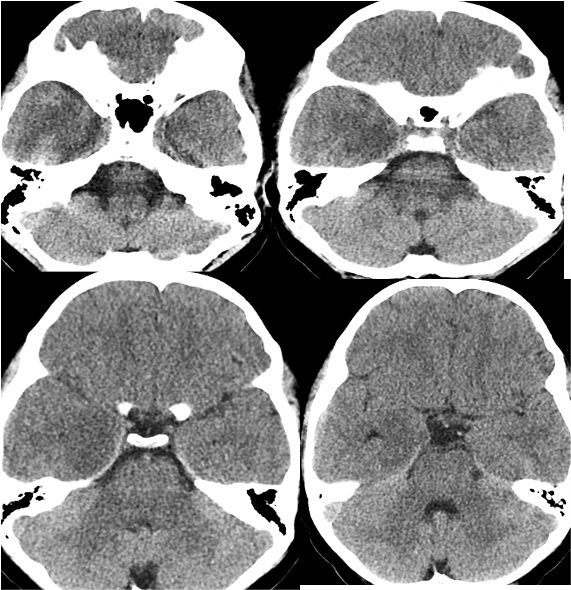Ganglioglioma
An 11-year-old boy with frequent partial seizures and lip twisting for four years. Initial CT of brain was done without contrast as patient presented to ER. The patient needs further evaluation by MRI to rule out focal mass.
Clinical history: An 11-year-old boy with frequent partial seizures and lip twisting for four years. Initial CT of brain was done without contrast as patient presented to ER.

Low density lesion in medial aspect of right temporal lobe
Findings:
There is hypodensity at the medial aspect of right temporal lobe. The patient needs further evaluation by MRI to rule out focal mass.

Heterogeneous enhancing cortial based right medial temporal lesion with low signal in T1,high signal inT2 & FLAIR images with minimal perilesional edema.
An MRI of the brain was done with and without contrast. There is heterogeneously enhancing lesion at the most medial part of right temporal lobe. It measures 2.5 cm by 2.4 cm by 2 cm in maximum craniocaudal, transverse and AP dimensions. There is minimal white matter edema. It is causing minimal mass effect and prominence of right temporal pole over the suprasellar cistern. It has low T1, high T2, FLAIR signal intensity.
The differential would include dysembyoplastic neuroepithelial tumor, gangliocytoma / glioma. Most likely ganglioglioma. The differential includes dysembyoplastic neuroepithelial tumor, but it is less likely.
Operative findings:
Ganglioglioma, Grade I
Discussion:
Ganglioglioma is a tumor that arises from ganglion cells in the central nervous system.
A ganglioglioma is an uncommon central nervous system tumor which accounts for around 2 percent (from 0.4 percent to 3.8 percent) of all primary intracranial tumors; and up to 10 percent of primary cerebral tumors in children. They are however the most frequent of the neuronal-glial central nervous system neoplasms.
They are of low grade (WHO Grade I or II). Typical occurrence is in the temporal lobes, although they have been described in all parts of the central nervous system.
Epidemiology:
Children and young patients are usually affected, and no gender predominance is recognized.
Clinical presentation:
The most common presentation is with temporal lobe epilepsy, presumably due to the temporal lobes being a favored location.
Ganglioglioma was first described by Courville in 1930 as a central nervous system neoplasm containing both astrocytic and neuronal components. Gangliogliomas may occur anywhere in the central nervous system but are not encountered commonly.
Similar to other brain tumors, imaging techniques define the location of gangliogliomas and their relationship to adjacent structures. Because of the relative rarity and nonspecific appearance of these lesions, gangliogliomas are only infrequently considered a presurgical diagnosis.
Differential diagnosis:
The differential diagnosis is very broad and should be restricted by location.
If in the temporal lobe consider:
• pleomorphic xanthoastrocytoma (PXA)
• Ganglioglioma
• ganglioneuroma
• pilocytic astrocytoma
• dysembyoplastic neuroepithelial tumour (DNET)
Temporal lobe tumor differential diagnosis
If in the spinal cord consider:
• astrocytoma
• ependymoma
For cortical tumors consider:
• oligodendroglioma
• pleomorphic xanthoastrocytoma (PXA)
• ganglioneuroma
References:
http://emedicine.medscape.com/article/340632-overview#a01
http://radiopaedia.org/articles/ganglioglioma
http://neuro-oncology.oxfordjournals.org/content/9/2/124.full
http://radiographics.rsna.org/content/22/5/1177.full
Sushila Ladumor, MD, FRCR, consultant radiologist with multi-modality imaging experience, working in Medical Imaging Department, King Abdulaziz Medical City, Riyadh, Saudi Arabia.
Clarius Mobile Health Unveils Anterior Knee Feature for Handheld Ultrasound
April 23rd 2025The T-Mode Anterior Knee feature reportedly offers a combination of automated segmentation and real-time conversion of grayscale ultrasound images into color-coded visuals that bolster understanding for novice ultrasound users.
The Reading Room Podcast: Current Perspectives on the Updated Appropriate Use Criteria for Brain PET
March 18th 2025In a new podcast, Satoshi Minoshima, M.D., Ph.D., and James Williams, Ph.D., share their insights on the recently updated appropriate use criteria for amyloid PET and tau PET in patients with mild cognitive impairment.
What is the Best Use of AI in CT Lung Cancer Screening?
April 18th 2025In comparison to radiologist assessment, the use of AI to pre-screen patients with low-dose CT lung cancer screening provided a 12 percent reduction in mean interpretation time with a slight increase in specificity and a slight decrease in the recall rate, according to new research.